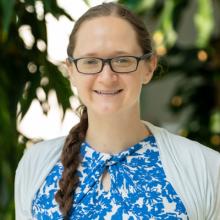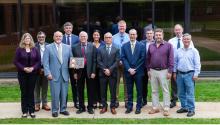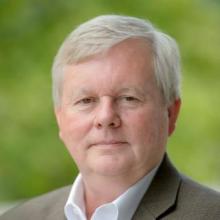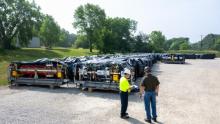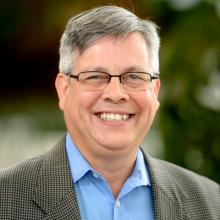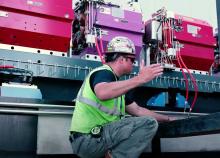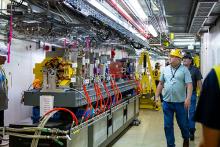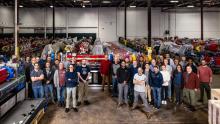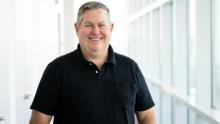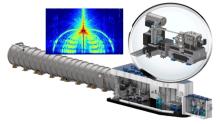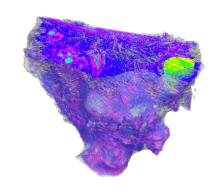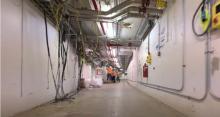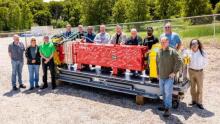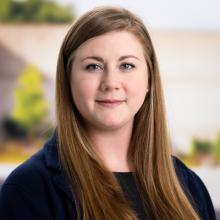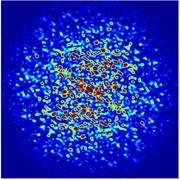News Feed - APS/User News
I am protecting people: Beth Heyeck leads radiation safety program at the new Advanced Photon Source
As the radiological user facilities manager, Beth Heyeck and her team will be the main points of contact for safety measures as the upgraded APS starts its new life.
Work on the beamlines for the APS Upgrade is ramping up. One of the most visible recent projects has been the assembly of the Grand Tube at beamline 9-ID, which this video depicts. The Grand Tube is a 70-foot-long enclosure that will allow scientists to image extremely small materials in three dimensions.
Eric Rod, Jesse Smith, Maddury Somayazulu, Jonathan Lang, John Quintana, and Nenad Velisavljevic were recognized for their contributions to nuclear security.
Dennis M. Mills, deputy associate laboratory director (DALD) for science and deputy director of the APS, will retire Nov. 6, 2023.
Scientists at Argonne are helping to repurpose magnets swapped out from the Laboratory’s Advanced Photon Source (APS) for use in a new machine being built in New York by two of Argonne’s sister DOE laboratories, Brookhaven National Laboratory and Thomas Jefferson National Accelerator Facility (Jefferson Lab).
Argonne will create and operate a suite of specialized capabilities that may help understand the effects of the changing climate on the air, water, soil and bioeconomy.

Two Photon Sciences (PSC) employees, Fanny Rodolakis, physicist, and Becky Sikes, lead foreign visit and assignment administrator for the APS user program office, have been recognized for their leadership of the PSC Diversity, Equity, Inclusion and Accessibility (DEIA) Council.

Register for the APS Upgrade session at the Canadian Light Source users meeting.
The Advanced Photon Source (APS) upgrade is well underway, and the facility will return to operation in 2024 with enhanced capabilities. Through the CLS@APS Partner User Program, Canadian users can access the APS beamlines. Thus the Canadian Light Source (CLS) will host a virtual session on the science potential of the upgraded APS on Thursday, Oct. 26 as part of the CLS Users Meeting
John Quintana has been selected by the interview committee to be Argonne’s Photon Sciences (PSC) directorate deputy associate laboratory director (DALD) for operations effective August 14, 2023.
The Advanced Photon Source (APS) upgrade project is in full swing. When it’s complete, the entire electron storage ring at the heart of the facility will be replaced with a state-of-the-art machine. The new storage ring will be made up of 1,321 powerful electromagnets assembled into 200 modules, each weighing more than 20 tons.

The Department of Energy (DOE) has announced a job opportunity for a Physical Scientist GS-1301-14/15 position to serve as a Program Manager for Scientific User Facilities (SUF) under the Basic Energy Sciences (BES) Program in the Office of Science (SC) located in Germantown, Maryland.
Just a few weeks after completing the removal of the original electron storage ring from the Advanced Photon Source (APS) facility, crews have begun moving in the first modules of the upgraded magnet lattice. This new storage ring, installed as part of the APS Upgrade Project, will result in X-ray beams that are up to 500 times brighter than those generated by the original APS.
The facility is undergoing a comprehensive upgrade. Afterwards, the new APS will be able to generate X-ray beams 500 times brighter.
A self-described “scientist who knows how to build things,” Winarski bridges worlds on a daily basis in his role with the upgrade project.
The Advanced Photon Source will hold a hybrid workshop to explore ideas for potential first experiments at the CSSI beamline. This two-day workshop will be held on Tuesday, August 1 and Wednesday, August 2, from 10:00 AM to 3:30 PM CT both days. Registrants can attend the session in person at the APS or virtually.
The Advanced Photon Source will hold a hybrid workshop to explore ideas for potential first experiments at the ISN and PtychoProbe beamlines. This two-day workshop will be held on Thursday, August 3 from 9 a.m. to 5 p.m. CT and Friday, August 4, from 9 a.m. to 2 p.m. CT. Registrants can attend the session in person at the APS or virtually. Remote attendees will be able to participate in discussions.
With the removal phase of the Advanced Photon Source (APS) Upgrade completed, the APS storage ring tunnel now stands empty for the first time since the early 1990s. The installation of the new, state-of-the-art storage ring will begin this summer.
In 1994, this magnet — among the last to be installed in the APS — was signed by those who worked on the original facility. In May, the magnet was removed
As floor coordinator, Wayman acts as a liaison between beamline staff and the rest of the Advanced Photon Source.
The Advanced Photon Source will hold a hybrid workshop to explore ideas for potential first experiments at the XPCS beamline at 8-ID. This hybrid workshop will take place over two full-day sessions on July 18 and July 19.

